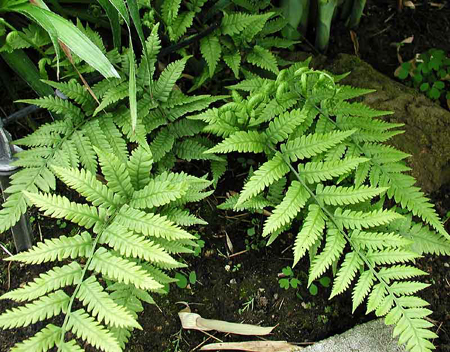| Deparia japonica | ||
Black lady fern | ||
|
Etymology
Japonica means Japanese.
Description
Rhizome: short-creeping, branching, scaly.
Frond: deciduous, somewhat dimorphic, the fertile ones taller, narrower, more erect, blade/stipe ratio: . Stipe: green or straw-clored, shallowly grooved above, swollen or not at base, densely scaly at base, upwards along with rachises scaly and multicellular-hairs, vascular bundles: 2, lunate. Blade: 1-pinnate-pinnatifid, oblong-lanceolate, gradually narrowed toward acuminate apex, sometimes slightly narrowed toward base, herbaceous, multi-cellular hairs along costae, rachis. Pinnae: 12 to 16 pair, linear to linear-lanceolate, to 12 cm long, 2.5 cm broad, halfway or deeply pinnatifid; costae grooved above, discontinuous with the rachis; margins serrate or lobed, blunt or acute at the tip; veins free. Sori: elongate, ± straight, or hooked at distal end, to 5 mm long, on veins, arranged generally in a herringbone pattern, indusium: linear, persistent, sinus, brown, sporangia: brownish. Culture
Habitat: woodland, lowlands, foothills.
Distribution: Himalayas, Malaysia, Vietnam, China, Korea, Japan, eastern Siberia.
Hardy to -20°C, USDA Zone 6, but given the range, provenance is important.
Synonyms
Asplenium japonicum Thunb Athyriopsis japonica (Thunb.) Ching Athyrium japonicum (Thunb.) Copeland Diplazium japonicum (Thunb.) Bedd. |
|
|
Notes
Compare to D. petersonii is similar, prevalent in tropical Asia, Australia; perhaps some of the distribution reported here is that species.
Compare to D. petersonii is similar, prevalent in tropical Asia, Australia; perhaps some of the distribution reported here is that species.
